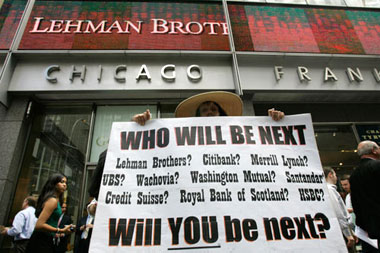全球金融
Where's the next Lehman?
下一個雷曼兄弟在哪兒?
Five years after the maelstrom of September 2008, global finance is safer. But still not safe enough
五年前國際金融歷經了2008年9月金融危機的沖擊,現在更加穩健了,但仍非萬無一失。
The bankruptcy of Lehman Brothers, an American investment bank, in 2008 turned a nasty credit crunch into the worst financial crisis in 80 years.
雷曼兄弟是一家美國投資銀行,2008年,該行的破產將一場嚴重的信貸緊縮變成了80年來最嚴重的經濟危機。
Massive bail-outs from governments and central banks staved off a second Depression, but failed to prevent a deep recession from which many rich economies have yet fully to recover.
政府和央行紛紛大規模救市,避免了經濟二次蕭條。然而,許多發達經濟體尚未完全恢復經濟發展活力,救市未能阻止一場嚴重衰退的降臨。

Five years after that calamity, two big questions need to be answered. Is global finance safer? And are more crises on the horizon?
繼金融危機發生后,時隔五年,擺在我們面前的兩個重要問題是:國際金融是否更加穩健了?是否會有更多危機即將來臨?
The quick answers are yes, and yes.
簡單來說,的確如此。
Global finance looks less vulnerable because reforms to the financial industry have made it more resilient, and because America, the country at the heart of the Lehman mess, has got rid of much of the excess debt and righted many of the imbalances in its economy.
由于金融業改革,國際金融更加能夠抵御沖擊。并且由于處于金融危機中心的美國,清理了大量超額債務并糾正了經濟運行中諸多不平衡因素,國際金融看起來不再那么不堪一擊了。
Today's danger zones are elsewhere. They are unlikely to spawn a collapse on the scale of 2008.
如今,危險的區域在別的地方,盡管這些國家不太可能在2008年的大規模金融危機中破產。
But they could produce enough turmoil to hit growth hard.
但是,它們卻制造了許多足以阻礙經濟增長的動蕩。
The disaster of September 2008 had many causes, as the first of our series of “schools briefs” makes clear.
正如本報“學派簡介”系列文章第一期中所闡明的那樣,2008年9月金融危機的成因有很多。
But, put crudely, Lehman's demise spawned catastrophe because it combined three separate vulnerabilities.
但是,籠統地講,雷曼兄弟破產之所以引發了一場大災難是因為它包含了三種不同的金融體系缺陷。
The underlying one was a surge in debt, particularly in the financial sector, brought on by a housing bubble.
根本的缺陷是,債務激增,尤其是在金融部門,這是由房地產泡沫所致。
The ensuing bust was made more dangerous because of the second weakness: the complex interconnections of securitised finance meant that no one understood what assets were worth or who owed what.
由于金融體系的第二個缺陷,即:證券化融資的復雜聯系意味著沒有人理解什么資產有價值及誰擁有什么資產,因此,隨后發生的蕭條更加危險。
Lehman's failure added a third devastating dimension: confusion about whether governments could, or would, step in as finance failed.
雷曼兄弟的破產增加了第三種破壞因素,即:對于當金融業遭遇危機時,政府是否可以及會不會插手干預的疑慮。
A rule of thumb for spotting future disaster is how far those weaknesses—a debt surge, ill-understood interconnections and uncertainty about a safety net—are repeated.
對于發現未來金融危機的經驗論觀點就是,這些缺陷(債務激增,誤解聯系,安全金融網絡的不確定因素)要重復出現多久。
The overhaul of financial regulation since 2008 has made most progress on the first two.
自2008年來,總體的金融監管工作已經在克服前兩個缺陷上取得了進展。
Under the new Basel capital standards banks are being compelled to hold more, and better, capital relative to their assets; the biggest “systemic” banks even more than others.
在新巴塞爾資本標準要求下,銀行被迫持有更多更好的和資產相關的資本;比起其他國家,擁有甚至更多的最大系統性銀行。
Another strand of reforms, such as pushing derivatives trading onto clearing-houses, has tried to improve transparency.
另一改革鏈已成功提高了透明度,比如:將衍生品交易轉移到結算所。
Least progress has been made on what to do when big banks fail—though new efforts to write global rules that would force banks to issue bonds that can be “bailed in” in the event of failure is a promising step.
盡管制定國際規則的新一輪努力是充滿希望的,該國際規則將迫使銀行在經營失敗時發放保釋證券,但就大銀行經營失敗時所應當采取的措施而言,幾乎未取得進展。
American finance has become safer.
美國的金融體系已經變的更加穩健了。
The country's big banks have raised more capital and written off more dud assets than most others.
比起其他國家的銀行,該國的大銀行已籌集了更多資本并注銷了更多不良資產。
At around 13%, their risk-weighted capital ratio is far above the new global norms and some 60% higher than before the crisis.
美國這些大銀行的風險加權資本比例大約為13%,遠高于國際規范,并且比危機之前高約60%。
American property prices have adjusted and households have cut their debts.
美國的房地產價格已得以調整,并且美國家庭的債務得以削減。
Government debt has risen, but most of that rise is the sensible mirror-image of efforts by households to reduce theirs.
政府債務高漲,其大部分漲幅清晰地折射出了美國家庭在努力地削減自身債務。
Now that the economy is recovering, the budget deficit is tumbling.
由于經濟逐漸回暖,預算赤字也巨幅下滑。



